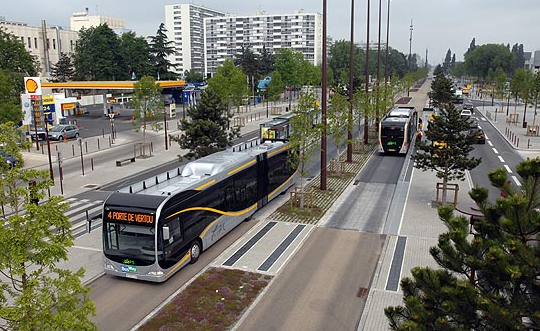Source: The Transport Politic by Yonah Freemark
Photo: BusWay in Nantes, France, from City of Nantes
Reserving respect for each mode.
As if operating in parallel, Toronto’s Globe and Mail and The Wall Street Journal each published articles last week describing the merits of bus rapid transit, which each newspaper described as the future of urban transportation.
Both noted that BRT was cheaper to construct than rail lines. Each suggested that in an age of government pull backs and general skepticism over the value of public investment, BRT could offer substantial benefits to a transit system at a reasonable price. And each article concluded with a warning by rail proponents that buses wouldn’t be able to attract people out of their cars.
This is a sensationalized opposition between two modes of transportation that should be thought of as complementary. There are advantages to improved bus service in some corridors, reasons to support rail in others.
What is clear is that for the majority of American cities — excluding only a few in the Northeast — buses will remain the predominant mode of public transit for most riders, even after major expansions in train networks planned for cities from Charlotte to Phoenix. So even cities that choose to invest in rail projects must also spend on the improvement of their bus lines.
Nor is the difference in costs between rail lines and BRT nearly as great as some would argue. The Journal article quotes Dennis Hinebaugh, head of a transportation center at the University of South Florida, saying “You can build up to 10 BRT lines for the cost of one light-rail line.” That might be true if you’re comparing a train operating entirely in its own right-of-way with a bus running in a lane painted on the street. But a streetcar is probably cheaper than a busway. Just ask Hartford, whose busway project will cost $60 million a mile to build.
Just as importantly, the argument made in the Journal by Simon Fraser University Professor Anthony Perl that “Rail has a proven record of being able to take people of their cars; buses don’t,” is quite frankly premised on antiquated views about the differences between buses and trains. A well thought-through BRT line, operating in its own right-of-way, can offer riders most, and sometimes more, of the comfort, convenience, and accessibility of a rail line.
The Globe and Mail notes that “LRT advocates often argue that light rail has better interaction with the streetscape and is a better way of achieving dense, transit-oriented development than BRT,” and indeed, that point is frequently made. But plenty of vibrant neighborhoods in American cities have developed just fine without rail. The City of Seattle, whose first modern light rail line opened in 2009, nevertheless has been densifying for decades, increasing in population from 494,000 in 1980 to 609,000 in 2010 (with no annexation).
The best argument for rail is that it has the ability to provide massive rush-hour passenger-carrying capacity without destroying the city through which it runs. Whether buried in a subway or operating quietly along in grassy medians, trains can be integrated into the public realm without diminishing the pedestrians-friendly qualities all urbanists should hope to encourage. BRT boosters often argue that their mode of choice can carry a similar number of riders, but neglect to mention that this is only possible when buses arrive every 10 seconds along highway-like four-lane corridors. These are conditions that destroy the walking environment.
Fortunately for American cities looking to invest in new public transportation infrastructure, there are few places that demand the passenger-carrying capacity provided by those freeway-based BRT lines in places like Bogotá. In most metropolitan areas, a two-lane busway inserted on an arterial is perfectly appropriate and sometimes even beneficial for a city. Indeed, as we all know, the story that is too complicated for any mainstream paper to explain is that BRT can mean any number of things. The most rudimentary elements of BRT — the nice buses, the well-articulated stops, the traffic signal priority — are basics we should expect from all of our bus lines. Pushing for their implementation along certain corridors shouldn’t arouse much controversy.
But these points are rarely discussed when the argument between modes are made.
The real divisions between bus and rail are political: For those who would fight for improved transit systems in their cities, the truth is that rail projects do certainly have more appeal among members of the public. Thus a billion-dollar rail project may be easier to stomach for a taxpaying and voting member of the citizenry than a quarter-billion BRT line. While the former is qualitatively different than what most car drivers are used to, the latter mode is too easily lumped in with the city bus, which car users have already paid to avoid.
Better transit can come in many forms, but in a country in which the vast majority of people have no contact with public transportation this side of Disney World, making the argument for investments in more buses is difficult, to say the least. BRT is just not sexy until you’ve experienced it. Which is why the considerable success of BRT in South America has not convinced many U.S. cities to abandon their ambitions for more rail.
Articles like those in the Journal and the Globe and Mail, despite their positive assessments of the potential for BRT, nonetheless reinforce the sense that BRT is inferior to rail by putting the two in contrast to one another, rather than focusing on the relative benefits of each. By continuously describing BRT as an economical way to get something like light rail, all that comes across is that it’s cheap.
¿Comments? ¿Opinions? ¿Similar News? Send them to us!













